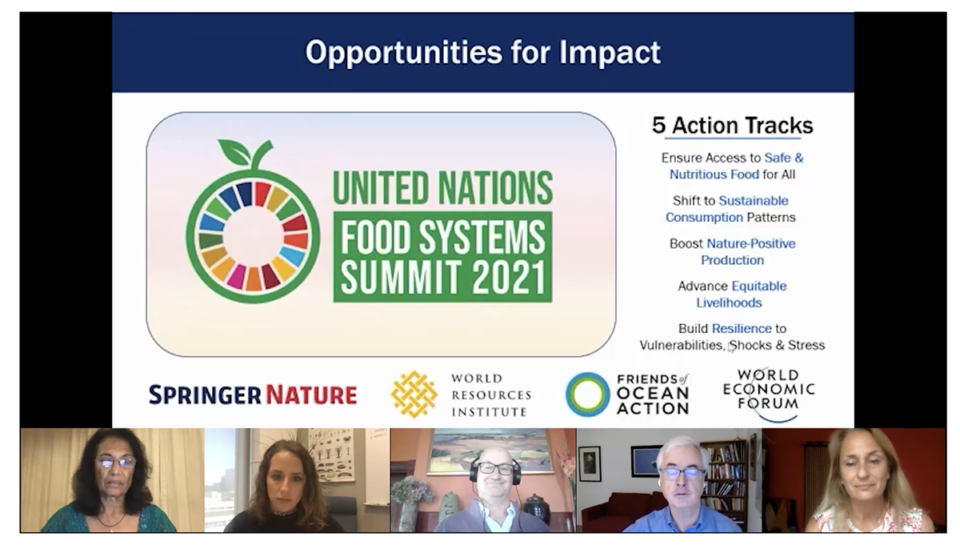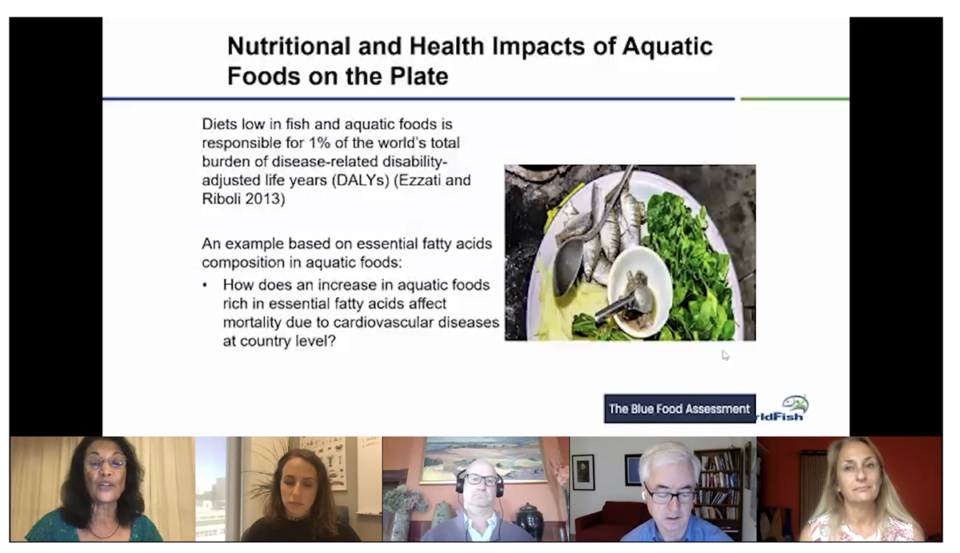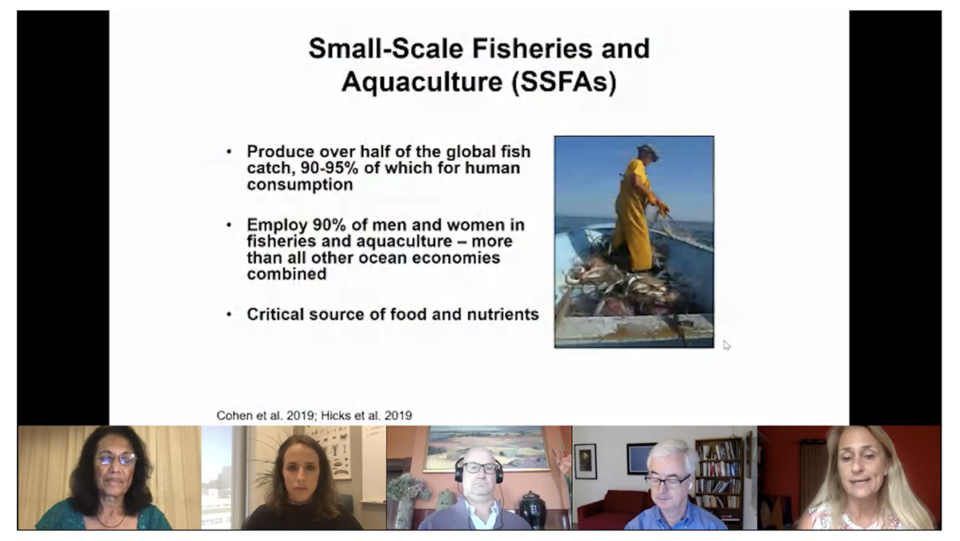Global Aquaculture Alliance’s annual conference broadens its scope as the organization looks to do the same

Fisheries and aquaculture both have critical roles to play in the future of our food systems. With the global population projected to reach 10 billion by the year 2050, the growing importance of blue food is evident, according to Jim Leape, co-director of the Stanford Center for Ocean Solutions and a member of the Blue Food Assessment (BFA) Core Team. The BFA is a collective of international, multidisciplinary scientists producing an important scientific assessment that will underpin discussions at the United Nations’ first global Food Systems Summit 2021, as well as other high-profile global events and food forums.
At the recent GOAL 2020 conference produced by the Global Aquaculture Alliance, Leape spoke about the importance of aquatic foods, which more than 3 billion people worldwide rely on for protein and micronutrients.
“It’s simply true that we cannot meet the needs and appetites of a world of 10 billion people by continuing to rely so heavily on agriculture, which is already the largest destroyer of biodiversity, the largest driver of deforestation, and the source of perhaps 30 percent of the world’s greenhouse gas emissions,” Leape said during the Oct. 8 session, which featured four members of the BFA core and scientific leadership teams. The session, titled “The Intersection of Wild Fisheries and Aquaculture,” was the first of its kind at GOAL, a taste of what is to come as GAA itself is transitioning to the Global Seafood Alliance. The organization’s CEO, Wally Stevens, detailed the importance of this new and unifying direction in his opening remarks.
For the BFA, the mission is to provide the scientific foundation for making blue food central to the conversations and policymaking defining how the food system needs to change. Key to that, Leape emphasized, is opening the lens through which aquatic foods are seen: “We need to be smart about charting the future of blue food,” he said.
And if any one word taken from Leape’s remarks or spoken throughout the ensuing panel discussions were to gain the greatest prominence in a word cloud, it would have been “diversity.” To build a food system that is healthy, environmentally sustainable and fair, Leape identified diversity as one of aquatic foods’ greatest strengths.
The huge diversity in species, production systems, and the role that aquatic foods play in broader diets provides opportunities to meet the needs that lie ahead and to build resiliency. Naturally, blue food has different possibilities and challenges in different parts of the world, so the diversity of contexts requires attention at many levels, from regional and national down to local and community levels.

Nutritionally necessary
Nutrition is a major theme within the BFA. Dr. Shakuntala Thilsted, research program leader for value chains and nutrition at Worldfish, provided an overview of current research.
“Increasingly, it is being recognized that aquatic foods are central to food and nutrition security of many globally,” said Thilsted. To maximize the contribution of aquatic foods toward nourishing human populations, the BFA research is aimed at providing additional data and deeper knowledge that can shape actions, policies and investments for healthy and sustainable diets.
Blue foods are extremely important for many millions of poor and undernourished people around the globe: Thilsted pointed out that in Africa and Asia, the essential fatty acids from fish are vital for pregnant or nursing women and for child development. In addition, said Thilsted, “the vitamins and minerals that are found in aquatic foods are of very high bioavailability – meaning, when you eat these foods, the absorption rate of the vitamins and minerals is high.”
Whether the goal is boosting child development in Bangladesh and Malawi or reducing cardiovascular disease in Denmark and other higher-income countries, nutrition is a cornerstone of blue food’s benefits.
BFA is generating an Aquatic Foods Composition Database that includes a wide variety of aquatic foods and product types (raw, processed and cooked). By combining the nutrient composition of blue foods with food consumption patterns, recommendations can be made for increasing or decreasing intakes of certain aquatic foods.
“In many countries, aquatic food is becoming increasingly less affordable, and therefore it is important to figure out the amounts that should be consumed to give the needed nutritional benefits,” said Thilsted.

A large role for small-scale actors
Small-scale harvesters and farmers produce more than half of the global fish harvest, 90 to 95 percent of which is for human consumption. This sector employs 90 percent of the men and women in fisheries and aquaculture, which is more than all other ocean economies combined.
In discussing the challenges and opportunities for small-scale actors in the global aquatic food system, Dr. Fiorenza Micheli, co-director of the Stanford Center for Ocean Solutions and Professor of Marine Science at Stanford, echoed the theme of diversity.
In both fisheries and aquaculture, she said, small-scale actors include those who own non-motorized boats and harvest by hand, as well as those who have fairly large investments in boats, gear, processing plants and transportation. Production might be for local consumption, or it might be for export.
“The focus of the research paper is to link this diversity to policies and interventions with the aim of supporting the viability of small-scale fisheries and aquaculture and their role in food and nutritional security,” Micheli said.
Tackling patterns of injustice in aquatic food systems
Dr. Jessica Gephart, assistant professor of environmental science at American University, discussed the issue of injustice in aquatic food systems. The diverse benefits aquatic foods provide to national economies, livelihoods and nutrition are not distributed equitably around the globe, she stated.
“We know part of this distribution is led by factors related to the environment, such as where the most productive ecosystems are, and countries that have the largest Exclusive Economic Zones,” she said. “In this analysis, we are controlling for that so we can understand some of the social factors that contribute to inequitable distribution.”
Environmental justice research suggests that inequities exist where social structures support an unequal distribution of benefits, such that marginalized communities or those in poverty often receive fewer benefits due primarily to their lack of recognition and political power. Several different aspects of justice give rise to questions such as: Do factors such as gender, class, age, ethnicity and lack of political voice systematically affect how benefits from aquatic foods (from production to consumption) are distributed?
The objective of the BFA research is to understand how patterns of injustice manifest themselves within blue foods, and to evaluate the causes of injustice in order to identify opportunities for changing undesirable patterns. The BFA analysis is additionally placing a keen focus on places where there are exemplary policies in place, so those policies can be applied by other governments in meeting challenges of inequity and injustice.
The researchers also discussed the interconnectedness of all research topics within the BFA, some of which could only be touched on briefly during this session but are further summarized on the BFA website.
Among other excellent questions in the question-and-answer period, an audience member asked how blue food ties into the blue economy development framework. “This is where most of the jobs and the revenue possibilities in the blue economy are,” Jim Leape responded, “and that is true locally, nationally and at a global level … so, it’s at the heart of it.”
Follow the Advocate on Twitter @GAA_Advocate
Now that you've finished reading the article ...
… we hope you’ll consider supporting our mission to document the evolution of the global aquaculture industry and share our vast network of contributors’ expansive knowledge every week.
By becoming a Global Seafood Alliance member, you’re ensuring that all of the pre-competitive work we do through member benefits, resources and events can continue. Individual membership costs just $50 a year. GSA individual and corporate members receive complimentary access to a series of GOAL virtual events beginning in April. Join now.
Not a GSA member? Join us.
Author
-

Laura Rose
Laura Rose is an independent consultant with a background in marine conservation, aquaculture, and international development. She is based in Washington, D.C. Follow her on Twitter @fish4good.
[109,111,99,46,108,105,97,109,103,64,55,55,55,46,101,115,111,114,46,97,114,117,97,108]
Tagged With
Related Posts

Responsibility
A wider view: Consensus on seafood’s planetary and human health benefits
Several recent reports echo the message that eating sustainable seafood can help save the planet while making significant gains in public health.

Responsibility
A wider view: It’s blue food’s time
There is urgency to conversations about the role of blue food in mitigating climate change, increasing momentum toward some specific goals.

Responsibility
Can nutrition-sensitive aquaculture futureproof fish farming?
Research finds that nutrition-sensitive aquaculture can benefit public health through diverse, nutrient-rich seafood, and enabling equitable access to it.

Responsibility
Identifying global opportunities for shellfish, seaweed aquaculture
Study identifies regions where commercial marine aquaculture may provide environmental and social benefits and potentially support ecosystem recovery.

